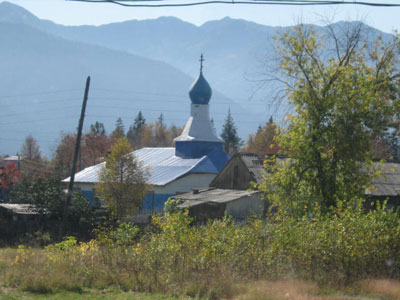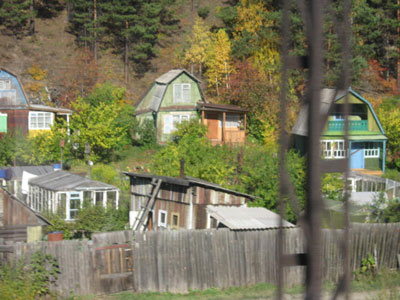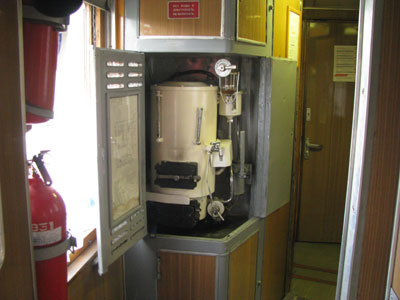70 hours on the Trans-Siberian Railway
This item appears on page 28 of the April 2014 issue.
My wife, Bonnie, and I took a month-long tour of China, Mongolia and Russia that included a 7½-hour daytime train ride from Ulan Ude, Russia, to Irkutsk, located to the west of the southern end of Lake Baikal. On Sept. 22, 2012, after finishing our organized tour, we continued on our own on the Trans-Siberian Railway from Irkutsk to Moscow, about a 70-hour trip, and flew home from there on Sept. 26.
Russian trains are punctual. Also, they run on Moscow time. In Irkutsk, we were five time zones ahead of Moscow, so we had to add five hours to the departure time indicated on our tickets. In many of the train stations there is a large clock; be aware that it indicates Moscow time.
We had the Russian tour operator Travel All Russia (offices in St. Petersburg, Russia, and Arlington, VA; 800/884-1721) obtain our required Russian invitation and rail tickets for us and also book our hotel in Moscow and our transfers from train station to hotel to airport.
We purchased four tickets in a second-class kupe (coupe), a 4-seat compartment with two upper berths and two lower ones, so we had the whole thing to ourselves. Normal procedure in Russia is for anyone, be they short or tall or a boy or girl, to be assigned a seat within a kupe, so you don’t necessarily know with whom you might be bunking. Lower bunks/seats are assigned odd numbers and uppers, even numbers.
Kupe bunks are relatively hard. There is a mattress about two inches thick, which helps, but you’ll feel it in your back muscles when you get up in the morning. After three nights, I became acclimated.
Each bunk had a large, somewhat hard pillow for resting your back on when sitting. The provodnitsa (train attendant) passed out sheets, pillow slips and hand towels shortly after we boarded. You make up your own bunk.
Our train originated in Mongolia. There were 11 Mongolian coaches. After crossing the border into Russia, a Russian dining car had been attached along with our coach, which must have been at least 50 years old. Bonnie and I were the only foreigners in this coach; everyone else was Russian.
At each end of the coach, there was a lavatory with a commode and sink, all of which emptied straight onto the railroad track. Toilet paper and hand towels were provided, as was a bar of soap, but carry your own, in any case.
To solve the problem of having to go down the hall to the bathroom at night, we each had a one-gallon zip-lock bag. These were very handy and could be emptied easily each morning. Bonnie used a ladies’ travel urinal, an item available in most travel stores.
Prior to boarding, we purchased a small plastic washbasin, which we each used to take a daily sponge bath. The coach samovar provided safe hot water for drinking and, in our case, bathing.
Meals were an issue. We had been warned that the dining car often ran out of food, so, prior to boarding, we had gone to the grocery store and purchased dark bread, cheese, salami and wine, in addition to bottled water, just in case. On our trips, we always carry breakfast bars, dried fruit and powdered decaffeinated coffee.
When I went to the dining car at about 5 p.m. to see what was available, the cook shouted something in Russian and held up two fingers. I returned later and there was nothing going on, so we dug into our provisions.
The second and third nights, we were able to purchase a meal from the dining car and have it delivered to our kupe. The cost for the two of us was about $20 each night, paid in rubles.
Their menu looked fantastic — caviar-filled crepes, etc. I would point to each entry thereon and the attendant would say either “Nyet” or “Da.” I believe there were a dozen or more entrées listed both in Russian and English, but fat chance that they had them all. (Incidentally, I never saw anyone eating in the dining car except the cook on the last day.)
The quality of the food left a lot to be desired. I wasn’t sure whether my beefsteak was yak, camel or a piece of the Little Tramp’s shoe. It was that tough.
At most of the train stops, which usually were 20 minutes in duration, there were food-and-drink kiosks. They sold noodles, fruit juices, soda, beer, vodka, water, etc. Some had fresh fruit, hard-boiled eggs and processed meats. Transactions were in rubles, as were those on board the train. Carry cash.
For some reason, the provodnitsa felt obligated to turn the heat on in the cabin regardless of the weather conditions. During our 10 days in Russia, they were having an Indian summer, with temperatures in the high 60s and low 70s F. I don’t believe the low got out of the 50s.
Using sign language, I asked the provodnitsa to turn the heat down and she did. I even got her to open the coach door leading to the vestibule between coaches, which allowed cooler outside air into our coach.
The dress code was terribly informal. Loose-fitting pajamas or T-shirts and shorts with flip-flops were the order of the day. Passengers generally lounged around, read and looked out the windows all day.
The literature typically describes the tiaga as the vast endless forest of Siberia. Originally, the Trans-Siberian Railway cut a swath through the forest on its approximately 5,000-mile route from Vladivostok to the Ural Mountains. Old stories tell of nothing but trees and more trees. Not the case in 2012!
While there were plenty of trees, we saw mostly farms and rural villages along the western half of our route. The scenery was much of the same every day, so take a good book.
We arrived in Moscow on time, at 2 p.m. on Sept. 25. We were to be met by someone carrying a sign with our names on it. Exiting our coach, the last of 13, we walked to the front of the train and found our man. He spoke fluent English and delivered us in his personal car to the Milan Hotel (Shipilovskaya St. 28A, Moscow), selected because of its proximity to the airport.
The Milan was very comfortable, and we had a fine dinner there as well. The meal cost about $100, as did a bottle of French wine. I had to get rid of those rubles anyway!
The next morning at 4:30 a.m., our transfer driver to the airport arrived. He spoke no English. In addition, he could not start the car, an older-model Mercedes-Benz. Finally, after he put the gear lever into neutral, at my suggestion, the engine started up. Thirty minutes later we were at the airport.
So what did all this cost us? $3,398 for two. According to Travel All Russia, it broke down as follows: four second-class kupe tickets at $2,699, one night’s hotel in Moscow at $324 and two transfers for $375. These amounts included fees and taxes associated with purchasing the products from their supplier.
For instance, train tickets had to be purchased with a Russian credit or debit card online or in person through one of their branch offices. The prices printed on our train tickets, which came to a total of $1,235, were much less than the costs required for making these arrangements as a foreign operator on Russian soil.
Was it worth it? Of course! How often does one get the chance to take such a memorable journey and enjoy these experiences?
There are two books potential rail riders may be interested in. Lonely Planet’s “Trans-Siberian Railway” (2012, fourth edition) is a contemporary account of Russian rail travel — the dos, don’ts and how tos.
We got the second from our local library. “To the Great Ocean: Siberia and the Trans-Siberian Railway” by Harmon Tupper (1965, Little, Brown & Co.) is a historical account, circa the 1890s, of the building of the Russian rail system.
SKIP CARPENTER
Coronado, CA



